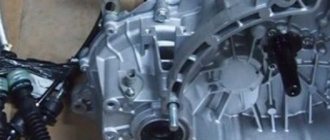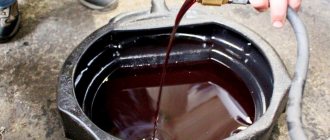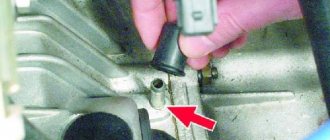It is well known that the engine and its systems have various seals and gaskets in their design, which provide the necessary seal at the junction of individual parts and elements. This seal allows the joints to be sealed, which prevents the leakage of engine oil and other technical fluids.
At the same time, during the operation of the car, the owner may quite often encounter the fact that the oil still begins to leak. In some cases, the lubricant actively pollutes the engine from the outside, oil gets into the spark plug wells, flows out from under the oil filter, camshaft or crankshaft seals leak, etc.
We also recommend reading the article about why oil leaks from under the oil filter. From this article you will learn about the causes of such oil leaks, as well as the available methods of troubleshooting.
It is important to understand that oil leaks not only lead to increased consumption of lubricant and pollute the internal combustion engine, but also cause various malfunctions, that is, they affect the operation of the engine. One of these common problems is considered to be the problem when oil is found in the spark plug wells. Next we will talk about the reason for oil getting into the spark plug wells, as well as how to fix such a leak with your own hands.
Oil in spark plug wells: cause of malfunction and possible consequences
Note that the appearance of oil in the area of the spark plug well is quite common on different internal combustion engines. Next, we will look at the problem using the example of 16-valve engines that are installed on the domestic Lada Priora model.
It should be separately added that such a problem can arise both on used cars and on practically new ones. In this case, this malfunction should be corrected immediately, since oil getting into the wells can lead to more serious complications.
If oil is present in the spark plug well, then this leads to softening of the rubber elements (spark plug insulator, high-voltage armored wires). As a result, spark breakdowns, cylinder misfires occur, the engine starts poorly, stalls, and loses power. In the future, various elements of the ignition system (coil, spark plugs, etc.) may fail.
We also recommend reading the article about why misfires occur. From this article you will learn about possible causes of the malfunction, as well as ways to diagnose and solve this problem.
Such failures can cause the engine “check” to light up on the dashboard, the engine requires constant computer diagnostics and error reset, not to mention the reduced service life of the spark plugs themselves, explosive wires and other parts.
So let's get back to the reasons. To begin with, oil usually enters the spark plug wells through leaks in the valve cover gasket area or through the spark plug well seals. On many engines, a rubber gasket is installed under the valve cover for sealing, and various types of sealants (anaerobic, silicone, etc.) have also recently become widespread.
Oil leaks often occur on internal combustion engines, where the valve cover is initially seated only on a sealant. In other words, the manufacturer itself does not provide for the installation of a rubber gasket in order to simplify and reduce the cost of the overall design.
Gradual drying of the sealant, errors in its application, as well as the use of low-quality compounds lead to the fact that such a seal begins to leak, much faster than a conventional gasket. Owners of the Priora model noted cases when oil appeared in the spark plug wells even on new cars. The fact is that during the long period of inactivity of the car in the car dealership, the sealant simply had time to dry out.
For what reasons does soot appear on candles?
Now it is possible to use many methods when diagnosing a car and its engine. The most common are:
- Computer diagnostics;
- Measurement of compression indicators;
- Use of external inspection of damaged parts.
However, one of the ways that can accurately indicate the occurrence of malfunctions in the engine is the appearance of carbon deposits on the spark plugs, the cause of which lies in the engine.
What does the appearance of carbon deposits on candles indicate?
By examining the appearance of the removed spark plugs, a specialist can easily determine the current condition of the main power units, as well as malfunctions in the operation of the vehicle’s auxiliary components and systems.
Depending on the color and degree of carbon deposits observed on the spark plug, auto mechanics accurately determine the diagnosis of the engine. At the same time, an understanding is formed - the engine operates primarily on a rich or lean fuel mixture. Also, a different color shade of soot on a set of spark plugs indicates specific reasons for poor engine performance.
The main malfunctions include:
- Change for the worse in the quality of the air-fuel mixture that forms carbon deposits.
- The quality of the system that is installed by the injector program.
- Problems appearing in the carburetor settings. The result is an overflow of fuel when the pump is running and the formation of black carbon marks on the spark plugs.
- Sudden wear of spare parts of the ignition system.
- Problems with ignition control. Changing the advance angle, which, in turn, affects the timely appearance of the spark and the possibility of engine detonation.
- Acceleration of wear in valve system seals. Characterized by the appearance of a black coating on the skirt.
- Wear before the expiration date of cylinder-piston groups, which, in turn, increases deposits in the form of carbon deposits.
- Significant wear of the ellipse in the block, the set of piston rings and the piston design itself.
Advice: in order to see the reason for poor engine performance, you don’t always need to go to a car service center. First, remove the set of spark plugs from the cylinder block and look at the color of the carbon deposits that appear. The indicator symbols on the instrument panel will also indicate problems with the engine.
What does the color of soot deposits indicate?
Using a color shade, you can quickly understand what problem areas are in the engine of your car. However, simply replacing samples will not solve the cause of soot - new spark plugs will very quickly become unusable. Currently, there are 3 main colors of deposits in the ignition system.
Each of the colors presented indicates the occurrence of a specific malfunction or group of problems in the car’s engine.
The appearance of black soot
This plaque can be either dry or oily. The appearance of a black coating in dry form indicates that an enriched mixture is being supplied to the engine. Candles become covered with such soot as a result of:
- Incorrect operation of carburetor systems;
- Clogged air filters;
- High pressure at the stage of fuel supply to the fuel rail;
- Little spark energy;
- Weak compression.
This is interesting: How to choose a mass air flow sensor
If black oily deposits appear, it is necessary to check the possibility of oil getting into the combustible fuel mixture itself. As a rule, oil leaks as a result of wear of the oil scraper type piston ring set. In addition, the cause of oil deposits can be damage to the valve system caps.
Advice: if you have recently repaired a VAZ-2114 generator, be sure to check the spark plugs. Perhaps some of the problems with the car lie there.
The appearance of white soot
White deposits in the ignition system can have several color shades:
- Slightly ashy colored deposits. Appear as a result of engine operation on low-quality gasoline samples. To solve the problem, you just need to remove and wipe the spark plug rings, after which they will become suitable for use again.
- Shiny white soot. Indicates the appearance of erosion on the body of the contact electrodes. It occurs as a result of overheating of the ignition system, and the cause may also lie in an insufficiently enriched fuel mixture. In addition, problems with early ignition and breakdowns in the cooling system can give such a tint. If the deposits are shiny white, it is best to replace the entire set.
Tip: if the spark appears weakly, a situation may occur when the car jerks when you press the gas pedal. This is also a common cause of a faulty spark plug set.
Self-fixing oil leaks in spark plug wells
Taking into account the above information, it becomes clear that for normal operation of the ignition system, even a minor leak that leads to oil accumulation in the well area must be eliminated. However, not all drivers know what to do if there is oil in the spark plug wells. Let's look at how to remove oil from spark plug wells and make such repairs yourself.
Let us immediately note that although this procedure is not complicated, without certain skills it will still be correct to contact a service center and entrust the car to specialists. If you solve this problem yourself, then you will need:
- remove the intake manifold;
- remove the timing belt casing;
- remove the timing belt;
- remove the valve cover;
- remove the camshaft from the bed;
These works will allow you to gain free access and fully remove the old layer of sealant from elements and surfaces, as well as efficiently apply a fresh compound. Please note that it is imperative to completely remove the old sealant. Any residues may interfere with subsequent sealing of parts using the new composition. In this case, the entire complex of work will need to be carried out again.
In this case, it is necessary to remove the old layer of sealant carefully, that is, do not use sharp hard objects or abrasives. The fact is that the appearance of scratches and burrs on the mating surfaces can lead to the fact that even after applying fresh sealant it will not be possible to achieve tightness after joining the parts.
As a result, the oil leak will continue, additional air leaks may appear, etc. For this reason, the old sealant is removed with chemical solvents. For this, use acetone, white spirit or regular gasoline. A small piece of cloth is soaked in a solvent, after which the surface is thoroughly wiped off to remove the old sealing compound.
Fresh sealant is then applied to the surface of the valve cover and reassembled. As for the sealant itself, the best option for these purposes is an anaerobic sealant. During assembly, it is also important to consider the order and tightening torque of the mounting bolts when installing the valve cover.
Useful tips
As you can see, replacing the sealant under the valve cover is not a complicated procedure. The main requirements include thorough cleaning of the old layer and proper application of fresh sealant to the surface.
The applied layer must be even and no interruption is allowed. It should also be noted that the sealing compound must also be used to treat the joints between the connections of the spark plug wells, having previously removed the old sealant from there.
Let us add that these areas, as a rule, are generously covered with a sealing compound, which will require some effort to fully clean such surfaces. To process the connections of the spark plug wells, a special red sealant is used, which can be purchased at car dealerships.
If only one engine needs to be repaired, then it will be enough to purchase a small tube of heat-resistant sealant. You can also read about selecting the best sealant for the engine in our separate article.
It should be noted that the use of sealant if the valve cover on a particular internal combustion engine is installed through a rubber gasket is undesirable. In this case, it is necessary to purchase a new high-quality gasket, after which the mating surfaces are checked. Next, the new valve cover gasket is installed in place, after which the valve cover is tightened, taking into account the order and torque of the fasteners.
What's the result?
- As a rule, it is possible to solve the problem of oil in spark plug wells with minimal financial costs. Even if you purchase an expensive professional sealant, the price of a small tube remains quite affordable.
After removing the oil from the wells, replacing the spark plugs and high-voltage wires may also be necessary to restore normal engine operation. The reason may be that the oil in the wells quickly softens and damages the rubber insulation.
- We would like to add that in some cases it is not necessary to change the spark plugs at the initial stage, but it may be necessary to clean the spark plugs separately. Only after removing dirt and carbon deposits will the power unit operate stably and smoothly.
- If mistakes were made during the application of the sealant, then the oil leak may continue in the future. For example, anaerobic sealants only cure when there is no contact with air. It turns out that if it is not possible to achieve a tight fit of the surfaces, then the composition will remain liquid and the seam will not be sealed.
How to solve a problem?
In most cases, the solution to oil getting into the spark plug wells on 1.6 liter engines is to remove the valve covers, add a good quality sealant, and reinstall the covers. If you have a 1.5-liter engine, but you also find oil in the spark plug wells, then in this situation the problem in most cases is associated with wear of the oil seals, they are also called gaskets or seals. O-rings are installed in the upper and lower parts of the spark plug wells, each glass has 2 seals, that is, there are 8 of them. The solution to the problem is to remove the oil from the wells, then replace the spark plug well seals.











